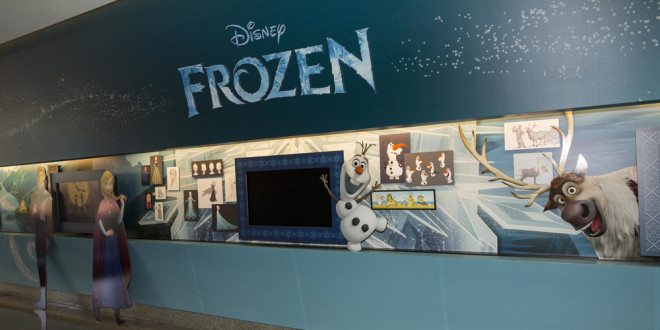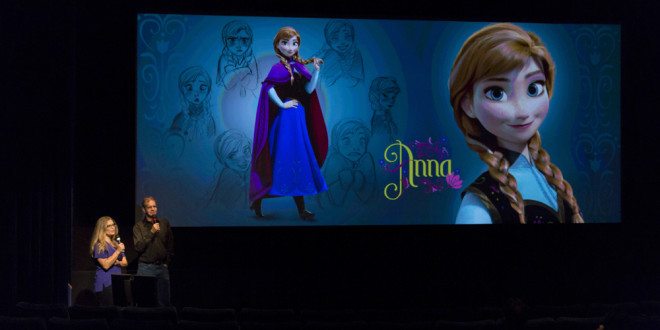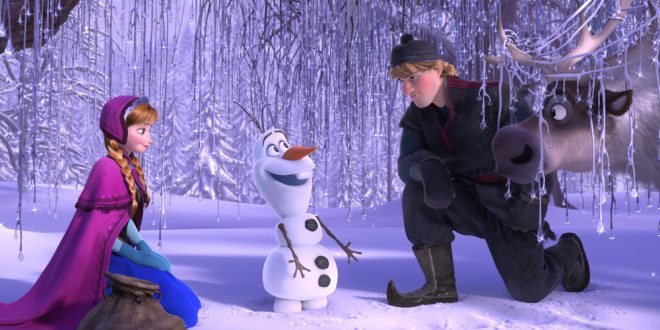
It’s less than two months until Disney’s latest animated film Frozen is due in theaters, and the anticipation is building at a–pardon the expression–heated pace. That’s by design, of course; the Disney machine is nothing if not efficient at reaching out to its base of fans through its vast array of entertainment outlets. Each little morsel released–be it poster art, footage, music, a trailer, a longer trailer, whatever–has been carefully parceled out to achieve the maximum fan response while still keeping a sense of mystery. And it’s worked. Some folks are so enthusiastic about this movie they cosplayed as the characters at the D23 Expo this summer. This was in August. For a movie they won’t get to see until Thanksgiving.
In case you haven’t been following the buzz, Frozen is loosely based on the Hans Christian Andersen tale The Snow Queen. It stars the voices of Kristen Bell and Idina Menzel as two royal sisters, separated at a young age by tragedy. Menzel plays Elsa, the elder sister and first in line to the throne of Arendelle. Born with the power to control ice and snow, she remains guarded and secretive until she accidentally reveals her abilities in front of a crowd of terrified citizens. She flees in disgrace and unleashes a terrible snow storm, freezing the entire kingdom in an eternal winter and retreating to an ice fortress of her own creation. Bell provides the voice of younger sister Anna, who takes it upon herself to seek out her sister and convince her to restore the summer. Along the way, she receives help from a rugged mountain man named Kristoff (Jonathon Groff), his trusty reindeer Sven, and a snowman named Olaf (Josh Gad).
I won’t deny that I’m in that camp of fans excited about this film. Ever since I saw Menzel’s electrifying live performance of her character’s anthem “Let It Go” at that same August convention, I’ve been eager to see more. A couple of weeks ago I finally got the chance. At a press day for journalists at the Walt Disney Animation Studios in Burbank, Calif., I had the opportunity to peek inside the machine and meet some of the creative talents working behind the scenes on the technical and visual aspects of the film–from the rendering of snow, hair, and clothes to the production design and the characters themselves.
We also viewed nearly 30 minutes of the film, including two full musical numbers: “Let It Go,” in which Elsa finally unleashes the powers she’s been keeping in check all these years, and Olaf’s song “In Summer,” about all the things he’s going to do when it’s warm again (not realizing, of course, what happens to snow when it melts). All the original songs were written by husband and wife team Robert “Bobby” Lopez (Book of Mormon, Avenue Q) and Kristen Anderson-Lopez (who previously worked with her husband on the Winnie the Pooh movie).
Toward the end of the day I had a chance to speak with the film’s co-directors, Chris Buck and Jennifer Lee (who now has the distinction of being the first woman to have a directing credit on a Disney animated film). Buck has had a long association with Disney, having gotten his start as an animator and working his way up through the ranks to direct the 1999 animated film Tarzan. Lee, meanwhile, makes her directing debut with Frozen, which she also co-wrote. She came to the project by way of a screenwriting gig on the most recent Disney animated feature, Wreck-It Ralph. I kicked off the interview by asking them about the process of putting together the film’s impressive cast.

Could you talk about the casting and how it came together for this film?
Buck: Kristen Bell was here; our casting director brought her in for another project. I was working on The Snow Queen [as the film was originally called] at the time, and the casting director wanted me to meet Kristen; he thought she’d be perfect for one of our parts. And that was kind of it. I fell in love with her voice and her spirit. We went through a long casting process of trying to find the right Anna. She was like the first one we saw and she was it.
Lee: What I love about Kristen, first and foremost, is, like me, she believes that girls can be funny. So she was a fantastic collaborator. And I’d bring pages in and we’d say, “Play.” And she imbued it with herself. You know, it was very important to her to have a relatable heroine. And I’m always up for that. So we really found the voice of Anna with her. And it was the same with Josh. When you have characters that have to be sort of very organically funny and yet very genuine, you want them to speak genuine, you don’t want lines. And you want to just feel them. And so we did a lot more improvising with the two of them probably than anyone, but it was great.
Did Bobby Lopez have an influence in Josh Gad coming on because of their Book of Mormon connection?
Buck: Josh was already sort of in the Olaf camp before Bobby and Kristin even came on. I hadn’t even met Bobby and Kristin yet. And it was before he had done Book of Mormon. Josh was an actor here in L.A. and the casting director brought him in. So it just was an amazing coincidence. And then Josh can talk about how Bobby wrote these songs for him that were too high or something, because Bobby’s just messing with Josh, to have fun with him.
Lee: Jonathan was fun because these guys, before I came on, they thought a lot about Kristoff and the idea was that he wouldn’t talk very much, that he’d be very gruff.
Buck: Gruff mountain man.
Lee: Hard to crack. Hard to get in there and get him to emote. And Jonathan came in. (To Buck:) You can tell this [story].
Buck: I was in the booth with Jonathan. I was reading lines with him. And I thought he was doing a good job, you know? … And once he left I said, “Well, what do you think? I thought he was pretty good.” And the women were like, “Oh my god, his voice!”
Lee: I like to say he has a voice of butter. He’s just this wonderfully welcoming voice. And his character was evolving and becoming someone who more represents, sort of that, you know he’s got the honest goods kind of guy. And our themes are about fear and love and the power of the two of them and which can win. And every character represents some part of fear and love and he just, he has this wonderful way about him that is very genuine and real and yet he can tell you the hard truth and do it in a way where you’re like, “Okay.” I like characters that can actually talk. So that was a good find.
Buck: So actually he kind of influenced the character itself. And then Idina. Idina, amazing actress, amazing voice.

Lee: But you know one thing, you said it really well about her speaking voice compared to her singing voice and how perfect it is for Elsa because of the vulnerability. There’s a slight, when she talks, there’s a gentleness and a reserved quality that sounds vulnerable. And as Elsa got more complex and wasn’t sort of this hard villain, that became such a wonderful quality to have. And it really balanced with Kristen Bell.
Buck: When you’re casting, we have already done designs for the characters, and so it’s always about looking at that design with their voice. Sometimes it’s a little distracting if you watch them, because all actors are very charming and they have this wonderful charisma. But we’re not going to be able to use their face, so it’s all about their voice, and that’s what we do. We really look at the designs to make sure that voice really feels right.
Can you talk about Olaf? Does he have a backstory?
Lee: When Anna and Elsa were very little, and before Elsa’s powers accidentally hurt Anna, they played. They’d sneak away and play with her powers. And you see them roll the snowman. He’s not magical. He doesn’t come to life. But they name him Olaf and he likes warm hugs.
Buck: Anna even does this little face with buck teeth.
Lee: It inspires the look. And so when Elsa is singing “Let It Go” obviously the first thing she goes to is the last moment she was happy. And it was that moment. And so he’s imbued with that. He’s innocent love. Like I say, we keep saying, the real themes are sort of the power of love versus fear. And he represents the most innocent love. And he’s also got a lot of the young Anna’s characteristics, because I think to Elsa that’s who she really loved. And so he was just a lot of fun, and emotionally he’ll bring a lot that we weren’t able to show you yet, too. So he’s funny in the kids-state-the-obvious kind of way.
Buck: And he can say very poignant things too.
Lee: Very poignant, the way kids sometimes just go right to it.
How did the story evolve from the original Hans Christian Andersen version of The Snow Queen into Frozen?
Buck: There are some very basic parts of the story that are in our story. This theme of this young girl–Gerda is the girl in the story–who won’t give up on finding her friend Kai. … And Kai is living in fear. There’s a troll in it and a mirror and shards and all this stuff and Kai gets a shard stuck in his eye and he only sees the negative in the world and the fear. But Gerda somehow did not get the shard and the only thing she really has in her, she’s not a superhero or anything, but she has love. And it’s love that conquers fear in the end. She pursues her friend and saves her friend from the Snow Queen.
Lee: Yeah, the issue with the original for us in a lot of ways is it’s a very symbolic story. It’s very hard to translate symbolism into concrete things. Film is concrete, so you translate it. So the Snow Queen was not very well drawn; she was symbolic. And so we really imbued Kai in Elsa to give character. So you’ve got sort of that same core. And then obviously the setting, it is set mainly in Norway, Scandinavia. And there are trolls, we have our own version of the trolls. And there are certain people that Gerda meets along the way that we’ve sort of combined into characters. Because you’re always going back to it. Because, you know, it’s inspiring for many reasons, but certainly the theme.

Speaking of inspiration, can you talk about what inspired you to take on this project in the first place?
Buck: [I was] attracted to the story and that theme, and then also the environment. It’s a magical world. Snow and winter and ice, even without Elsa’s magic, is magical. So it’s an environment, as [animation studio head John Lasseter] always wants us to do, too. It’s like, “Take me to a place I’ve never seen. Take me to a world I’ve never seen. … Transport me.” And so it spoke to John. … I pitched an ending–I can’t really tell you what the ending is, because it’s pretty special–but that was the thing. Even though the story changed quite a bit throughout, that was always the constant. That was, “How do we get this ending? Let’s work toward this ending.”
Lee: For me, it was the sister story. I have a sister. I went to that immediately. But also, the potential for these characters to be more than anything you’d seen before in female characters. They’re both equally powerful, vulnerable, very real, very relatable. They have the weight of the world on their shoulders. I mean, they’ve got a kingdom one has accidentally put in peril, the other’s stuck in the middle. And I thought the stakes were high, and I loved that the stakes were on them. And then, this ending. I mean, there was an ending everyone had responded too, all of us, the minute we heard it. And when I came on, it was [studio president] Ed Catmull who said you have to earn that ending. And that was not going to be easy. And the movie got bigger and bigger and bigger in order to do that. And they went with it. But those were the two biggest things for me. And everything went from there. I was just hooked, I guess.
Buck: What I think is great about this studio, Disney itself, is that we can do all these different types of movies. And we try to keep it fresh for us and we try to keep it fresh for the audience.
Lee:: Yeah. And what’s great is they really support the differences. … The thing we never can compromise on is the story. It has to be solid and resonate, but we have complete creative freedom. So you can have these two films that are completely different happening and we’re not being forced to make a style. It’s really about what we want to create. That’s been really cool, to do something that different.



1 thought on “Inside Disney's Frozen: Q&A with the Directors”
Comments are closed.